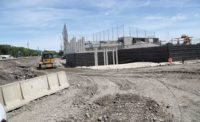...methods, such as vehicle miles traveled, offer a more predictable and reliable way to build a revenue stream,” says Bill Birkhofer, senior vice president of public sector sales for Jacobs Engineering Group, Pasadena, Calif.
Birkhofer, whose firm is part of the design-build team for the $197-million Interstate 95 widening and interchange project in Brevard County, Fla., adds that extension of the current funding system may ultimately benefit the industry, as well-packaged municipal bond and tax proposals for transportation garner success at the polls.
“There should be more than enough evidence of public support for a good highway/transit authorization measure once these other issues such as health care and clean energy are out of the way,” he says.
Transit Gains Traction
One sector widely expected to receive greater emphasis under a new federal funding package is transit, thanks to the convergence of long-standing trends such as increased urbanization and changing lifestyle preferences among Americans of all ages with the uptick of interest in more environmentally friendly, less petroleum-dependent means of mobility.
The project pipeline is already healthy. Major projects include Skanska’s $3.8-billion, 2-mile-long first phase of the Second Avenue Subway in Manhattan, and the $3.1-billion, 11.6-mile first phase of Washington, D.C.’s Metrorail system to Dulles International Airport being constructed by Dulles Transit Partners, the design-build consortium owned by Bechtel Infrastructure Inc. and the Washington division of URS.
Jacobs is providing construction-management services for the East Side Access project, which includes boring nearly seven miles of railroad tunnels in Manhattan and Queens, laying 50,000 ft of track, constructing a new terminal under Grand Central Terminal and building a new commuter station in Queens. New York City-based RailWorks Corp. is building a 28-mile, $1.8-billion extension of the DART Green Line in metropolitan Dallas and converting 26 miles of abandoned and underutilized tracks between Tacoma and Lakewood, Wash., into a new commuter rail line.
“This is a very exciting time for rail work,” adds Jeff Levy, RailWorks CEO, whose firm also is constructing the $215-million reconfiguration of the East 180th Street Yard in New York City, and has several freight rail improvement projects under way. “People have come to understand the role rail can play in helping address the challenges of global competitiveness, energy use and economic development.”
Adding to transit’s fortunes is the new interest in high-speed rail, fueled in part by $8 billion in stimulus funding, and the proposed development of 11 designated corridors across the country under the Passenger Rail Investment and Improvement Act of 2008. Expressions of interest to finance, design, construct and operate these projects are due to be submitted to the U.S. Dept. of Transportation this month, with an eye toward moving forward on the most promising initiatives in 2010.
Although construction of major high-speed rail projects is not expected in the near future, Cavallaro says the fact that governments are looking at rail is a positive sign. Still, a prolonged period of low gas prices could sap transit’s newfound momentum, particularly given the high costs that typically accompany major transit projects “Outside of urban areas where transit systems are already well established, it could be hard to sustain interest,” Cavallaro says.
“You still need local support to get federal funding, but a lack of revenue limits what these governments can do,” Levy agrees. As an example, he points to Boston’s Metropolitan Transit Authority, which has had to cut its $30-billion improvement program in half. Chicago, Washington, and other cities with heavily used systems also face significant funding shortfalls.
Positioning for a P3 revival
Despite the travails of the world’s financial markets, public-private partnerships remain a potential funding resource that could regain its attractiveness in the coming months. One year into its 14-mile, $1.4-billion P3 program to add high-occupancy toll (HOT) lanes to the Capital Beltway, Virginia Dept. of Transportation is exploring a similar strategy for a 28-mile stretch of Interstates 95 and 395. Several other P3 initiatives are under consideration in Texas, California, and New York, states that already have a track record with private-sector involvement.
Just how quickly other states adopt P3s depends on a lot of factors, says Flatiron’s French. “They need the right enabling legislation, and an understanding of how to work with long-term financing,” he says. “States also need to learn how to craft proper proposals that achieve the right amount of risk-sharing, and don’t leave everyone spinning their wheels.”
| Rank* | Firm |
|---|---|
| 1 | Bechtel |
| 2 | Kiewit Corp. |
| 3 | Granite Construction Inc. |
| 4 | The Walsh Group Ltd. |
| 5 | Flatiron Construction Corp. |
| 6 | Skanska USA Inc. |
| 7 | The Lane Construction Corp. |
| 8 | Jacobs |
| 9 | Clark Group |
| 10 | PCL Construction Enterprises Inc. |
| 11 | Williams Brothers Construction Co. |
| 12 | Austin Industries |
| 13 | American Bridge Co. |
| 14 | The Turner Corp. |
| 15 | Balfour Beatty Infrastructure Inc. |
| 16 | RailWorks Corp. |
| 17 | Great Lakes Dredge & Dock Corp. LLC |
| 18 | Ames Construction Inc. |
| 19 | The Hubbard Group |
| 20 | McCarthy Holdings Inc. |
| 21 | New Enterprise Stone & Lime Co. Inc. |
| 22 | The Kokosing Group |
| 23 | Fluor Corp. |
| 24 | Vecellio Group Inc. |
| 25 | Herzog Contracting Corp. |
| *BASED ON 2008 CONTRACTING REVENUE FROM TRANSPORTATION AS REPORTED IN ENR’S SURVEY OF LEADING CONTRACTORS AND DESIGN FIRMS. | |



Post a comment to this article
Report Abusive Comment